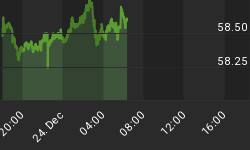
Default Risk vs. Interest Rate Risk
When bond investors are worried about the economy and default risks, it is concerning for stock investors. When bond investors are worried about rising interest rates, it is much less concerning for the equity markets. What is the primary fear in the bond market now? From Barron's:
As 2013 winds down, bond investors remain much more worried about interest-rate risk, which is what caused all those bond-fund price declines in May and June, than about default risk, or the risk that a bond issuer won't be able to pay back its debt. That what-me-worry attitude toward default risk gets further support from the latest statistics from Moody's Investor's Service, which reports today that the default rate among junk-rated U.S. companies fell further to 2.4% in November from 2.5% in October, barely more than half its long-term historic average and down from 3.1% a year ago.
Risk Insight For Stock Investors

The credit market (a.k.a. bond market) focuses on two major issues:
- How much does this bond pay?
- What are the odds of default?
When the market determines bond default probabilities, it includes an assessment of the economy. If the odds of a recession are low, then the odds of widespread bond defaults are also low. Conversely, if the odds of a recession are high, the odds of bond defaults also begin to increase. If you believe the odds of widespread bond defaults are low, then you would prefer to own a bond that pays a higher yield. If you believe the odds of bond defaults are rising, then you would prefer to own a higher rated and more conservative bond.
2007: Clear Warnings About Economy and Defaults
We can monitor the battle between yield and defaults by tracking the performance of higher yielding junk bonds (JNK) relative to more conservative Treasuries (TLT). Since JNK was not around in 2007, the chart below uses a mutual fund as a proxy for JNK. What was the bond market saying about the economy and default risks in late 2007? The aggregate opinion of bond market investors was pointing to bearish outcomes for both the economy and financial markets. The slope of the red line below reflects waning demand for more aggressive junk bonds relative to more conservative Treasuries.

In December 2013, the same ratio looks much more confident about future economic outcomes. Instead of a bearish "non-confirmation", the demand for more economically-sensitive junk bonds continues to be greater than the demand for defensive Treasuries, which speaks to ongoing confidence about future economic outcomes, and more importantly for bond holders, a reasonable expectation that they will receive their interest and principal payments.

How About 2013 vs. Recent Stock Market Corrections?
If you are more concerned about a stock market correction than a bear market, this video clip describes the chart below and how it relates to December 2013.

Are the credit markets 100% reliable in helping spot trouble in stocks? No, a credit market head fake came in Q1 2013, which is why the ratio of junk bonds to Treasuries is just one of many inputs to our market model.
Investment Implications - Trends Expected To Continue
Moody's is expecting a similar environment in the next year. From Barron's:
"Ample credit market liquidity along with stable, if not robust, economic growth have put defaults in 2013 on the same pace as what we saw in 2012," Moody's writes. "We expect this trend to continue in 2014."
As long as the weight of the evidence from the market's pricing mechanism points to greater demand for growth-oriented/higher-yielding assets relative to defensive assets, we will continue to hold our positions in U.S. stocks (SPY), technology (QQQ), financials (XLF), energy (XLE), China (FXI), and Europe (FEZ). With a Fed meeting next week, it is important that we continue to monitor the markets with a flexible and open mind.















